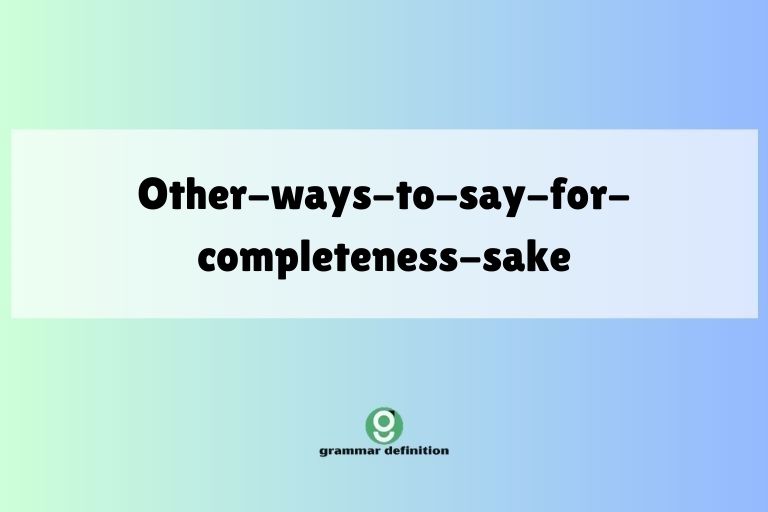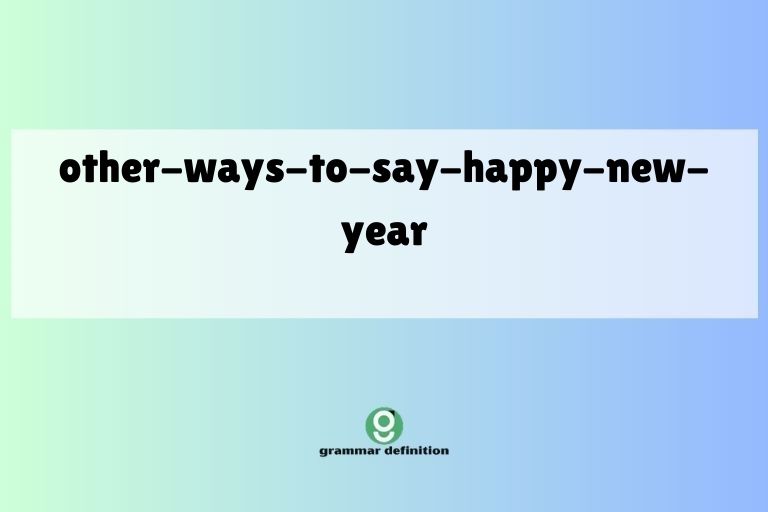Other Ways to Say “For Completeness’ Sake”: A Comprehensive Guide

The phrase “for completeness’ sake” is often used to indicate that something is being added or included to ensure a thorough and comprehensive understanding. While effective, relying on this single phrase can make your writing sound repetitive.
This article explores a variety of alternative expressions that convey the same meaning, each with its own nuance and suitability for different contexts. Mastering these alternatives will not only enhance your vocabulary but also make your writing more engaging and professional.
This guide is perfect for students, writers, and anyone looking to improve their communication skills.
By exploring these alternatives and understanding their nuances, you can choose the most appropriate phrase for the context, making your writing more precise and impactful. This guide will help you diversify your expression, improve clarity, and ensure your message is effectively delivered.
Table of Contents
- Introduction
- Definition and Explanation
- Structural Breakdown
- Types and Categories of Alternatives
- Examples
- Usage Rules
- Common Mistakes
- Practice Exercises
- Advanced Topics
- FAQ
- Conclusion
Definition and Explanation
The phrase “for completeness’ sake” is an idiomatic expression used to justify the inclusion of additional information, details, or perspectives to ensure a comprehensive and exhaustive presentation. It signifies a commitment to thoroughness and a desire to leave no gaps in understanding.
Essentially, it pre-empts the potential for questions or uncertainties by providing a fully rounded explanation.
The expression stems from the idea that completeness is a desirable quality, particularly in contexts where accuracy and comprehensive understanding are paramount. It suggests that the speaker or writer is going above and beyond to provide all relevant information, even if some of it may seem superfluous at first glance.
Classification: Idiomatic phrase
Function: To introduce additional information to ensure comprehensiveness.
Contexts: Academic writing, technical documentation, legal proceedings, presentations, and any situation where a thorough explanation is required.
Structural Breakdown
The phrase “for completeness’ sake” follows a straightforward prepositional structure:
For: A preposition indicating purpose or reason.
Completeness’: A possessive noun referring to the state of being complete or whole.
Sake: A noun meaning purpose, reason, or benefit.
The entire phrase functions as an adverbial phrase, modifying the verb in the sentence by providing the reason for the action being taken. For example, in the sentence “I included the data, for completeness’ sake,” the phrase explains why the data was included.
Types and Categories of Alternatives
There are many ways to express the idea of “for completeness’ sake,” each with slightly different connotations. Here are some common alternatives, categorized by their specific emphasis:
For the Sake of Thoroughness
This phrase emphasizes the importance of being meticulous and comprehensive in one’s approach. It suggests a commitment to leaving no stone unturned.
To Be Comprehensive
This option is more direct and formal, highlighting the aim to cover all aspects of a subject.
For the Record
This phrase is often used to ensure that something is officially noted, especially in formal or legal contexts. It implies a desire to document information accurately.
In the Interest of Accuracy
This alternative stresses the importance of correctness and precision. It is suitable when ensuring factual accuracy is a primary concern.
To Ensure Full Understanding
This option focuses on the audience’s comprehension. It indicates a desire to make the information as clear and accessible as possible.
For Clarity
This is a concise and straightforward alternative, emphasizing the goal of making something easier to understand.
For Good Measure
This phrase suggests adding something extra to ensure a desired outcome or to provide additional value.
To Cover All Bases
This idiom means to take all necessary precautions to avoid potential problems or failures. It conveys a sense of preparedness and foresight.
In the Name of Precision
This phrase is used when striving for exactness and meticulous detail. It is suitable for technical or scientific contexts.
To Leave No Stone Unturned
This idiom emphasizes a thorough and exhaustive investigation or examination. It suggests a relentless pursuit of all available information.
Examples
Below are several examples of how to use alternatives to “for completeness’ sake” in sentences, categorized by the alternative phrase.
Examples Using “For the Sake of Thoroughness”
The following table provides examples of using the phrase “For the Sake of Thoroughness” in different contexts. This phrase is used to emphasize the importance of being meticulous and comprehensive in one’s approach.
| Example | Context |
|---|---|
| For the sake of thoroughness, let’s review all the data points again. | Data analysis |
| The professor, for the sake of thoroughness, insisted on re-examining the historical documents. | Academic research |
| For the sake of thoroughness, we need to interview every witness. | Legal investigation |
| The engineer, for the sake of thoroughness, checked every connection twice. | Engineering |
| For the sake of thoroughness, the report included all relevant statistics. | Report writing |
| The doctor, for the sake of thoroughness, ordered additional tests. | Medical examination |
| For the sake of thoroughness, the team reviewed the code line by line. | Software development |
| The inspector, for the sake of thoroughness, examined every corner of the building. | Building inspection |
| For the sake of thoroughness, the manual included a detailed troubleshooting guide. | Technical documentation |
| The librarian, for the sake of thoroughness, cataloged every new arrival. | Library science |
| For the sake of thoroughness, the investigation team analyzed all possible leads. | Criminal Justice |
| The researcher, for the sake of thoroughness, read every article on the subject. | Scientific Research |
| For the sake of thoroughness, the accountant reviewed all financial records. | Accounting |
| The editor, for the sake of thoroughness, proofread the entire manuscript. | Publishing |
| For the sake of thoroughness, the chef tasted every dish before serving it. | Culinary Arts |
| The auditor, for the sake of thoroughness, verified every transaction. | Auditing |
| For the sake of thoroughness, the mechanic inspected every part of the engine. | Automotive Repair |
| The teacher, for the sake of thoroughness, graded every assignment carefully. | Education |
| For the sake of thoroughness, the historian cross-referenced multiple sources. | Historical Research |
| The analyst, for the sake of thoroughness, considered every potential scenario. | Business Analysis |
| For the sake of thoroughness, the security team checked every ID at the entrance. | Security |
| The gardener, for the sake of thoroughness, watered every plant in the garden. | Gardening |
| For the sake of thoroughness, the musician practiced every scale and chord. | Music |
| The artist, for the sake of thoroughness, sketched every detail of the landscape. | Art |
Examples Using “To Be Comprehensive”
The following table provides examples of using the phrase “To Be Comprehensive” in different contexts. This alternative is more direct and formal, highlighting the aim to cover all aspects of a subject.
| Example | Context |
|---|---|
| To be comprehensive, the report included all relevant data and analyses. | Report writing |
| The study aimed to be comprehensive in its assessment of the environmental impact. | Environmental science |
| To be comprehensive, the legal document covered every possible scenario. | Law |
| The researcher tried to be comprehensive in his literature review. | Academic research |
| To be comprehensive, the training program included modules on all aspects of the job. | Training and development |
| The encyclopedia aimed to be comprehensive in its coverage of world history. | Publishing |
| To be comprehensive, the website included a detailed FAQ section. | Web design |
| The investigation sought to be comprehensive in its examination of the evidence. | Criminal Justice |
| To be comprehensive, the insurance policy covered a wide range of potential risks. | Insurance |
| The curriculum was designed to be comprehensive in its approach to the subject matter. | Education |
| To be comprehensive, the cookbook included recipes from around the world. | Culinary Arts |
| The survey aimed to be comprehensive in its assessment of customer satisfaction. | Market Research |
| To be comprehensive, the audit examined all financial transactions. | Auditing |
| The documentary sought to be comprehensive in its portrayal of the historical event. | Film |
| To be comprehensive, the study included participants from diverse backgrounds. | Social Science Research |
| The guide aimed to be comprehensive in its instructions for using the software. | Technical Writing |
| To be comprehensive, the analysis considered both quantitative and qualitative data. | Data Analysis |
| The database was designed to be comprehensive in its storage of information. | Database Management |
| To be comprehensive, the presentation covered all key aspects of the project. | Business Communication |
| The assessment aimed to be comprehensive in its evaluation of the student’s skills. | Educational Assessment |
| To be comprehensive, the exhibition included artifacts from various periods. | Museum Curation |
| The review sought to be comprehensive in its critique of the book. | Literary Criticism |
| To be comprehensive, the inventory listed every item in the warehouse. | Inventory Management |
Examples Using “For the Record”
The following table illustrates the use of “For the Record” in different scenarios. This phrase is often used to ensure that something is officially noted, especially in formal or legal contexts.
| Example | Context |
|---|---|
| For the record, I was not present at the meeting. | Meeting minutes |
| For the record, the defendant denies all charges. | Legal proceedings |
| For the record, this decision was made unanimously by the board. | Corporate governance |
| For the record, the deadline has been extended to next Friday. | Project management |
| For the record, the witness statement was taken under oath. | Legal documentation |
| For the record, the experiment was repeated three times with consistent results. | Scientific research |
| For the record, the agreement was signed on July 15th. | Contract law |
| For the record, the complaint was filed on January 1st. | Customer service |
| For the record, the item was shipped on time. | Logistics |
| For the record, the payment was received on the 20th. | Finance |
| For the record, the policy was updated on March 1st. | Human resources |
| For the record, the budget was approved last week. | Budgeting |
| For the record, the proposal was rejected by the committee. | Proposal writing |
| For the record, the meeting was adjourned at 5 PM. | Meeting administration |
| For the record, the data was collected according to protocol. | Data collection |
| For the record, the information was verified by multiple sources. | Journalism |
| For the record, the equipment was calibrated before use. | Equipment maintenance |
| For the record, the code was reviewed by senior developers. | Software development |
| For the record, the feedback was incorporated into the design. | Design process |
| For the record, the safety measures were implemented as required. | Safety compliance |
Examples Using “In the Interest of Accuracy”
The following table illustrates the use of “In the Interest of Accuracy” in different scenarios. This alternative stresses the importance of correctness and precision.
| Example | Context |
|---|---|
| In the interest of accuracy, the data was verified by a third party. | Data validation |
| In the interest of accuracy, all measurements were taken using calibrated instruments. | Scientific measurement |
| In the interest of accuracy, the report was reviewed by multiple experts. | Report verification |
| In the interest of accuracy, the calculations were double-checked. | Mathematical computation |
| In the interest of accuracy, the information was cross-referenced with multiple sources. | Information verification |
| In the interest of accuracy, the translation was reviewed by a native speaker. | Translation services |
| In the interest of accuracy, the legal document was proofread by a lawyer. | Legal review |
| In the interest of accuracy, the historical account was verified by historians. | Historical verification |
| In the interest of accuracy, the medical diagnosis was confirmed by specialists. | Medical diagnosis |
| In the interest of accuracy, the financial statements were audited by a CPA. | Financial auditing |
| In the interest of accuracy, the survey results were analyzed using statistical methods. | Statistical analysis |
| In the interest of accuracy, the experimental results were replicated by another lab. | Experimental replication |
| In the interest of accuracy, the map was updated with the latest satellite imagery. | Cartography |
| In the interest of accuracy, the software was tested by beta users. | Software testing |
| In the interest of accuracy, the weather forecast was based on multiple models. | Meteorology |
| In the interest of accuracy, the demographic data was collected through census surveys. | Demographic research |
| In the interest of accuracy, the scientific article was peer-reviewed. | Scientific publishing |
| In the interest of accuracy, the economic forecast was based on econometric models. | Economic forecasting |
| In the interest of accuracy, the geological survey was conducted by experts. | Geological surveying |
| In the interest of accuracy, the archaeological findings were documented meticulously. | Archaeological documentation |
Usage Rules
When using alternatives to “for completeness’ sake,” consider the following rules:
- Context Matters: Choose the phrase that best fits the tone and purpose of your writing.
- Clarity is Key: Ensure the alternative phrase is clear and easily understood by your audience.
- Avoid Redundancy: Don’t use multiple phrases that convey the same meaning in close proximity.
- Formality: Some phrases are more formal than others. “For the record” and “in the interest of accuracy” are generally more formal than “for good measure.”
- Audience: Consider your audience when choosing a phrase. A technical audience might appreciate “in the name of precision,” while a general audience might prefer “to ensure full understanding.”
Common Mistakes
Here are some common mistakes to avoid when using these alternative phrases:
| Incorrect | Correct | Explanation |
|---|---|---|
| For completeness’ sake, and also for thoroughness, I added the appendix. | For the sake of thoroughness, I added the appendix. | Avoid using redundant phrases. |
| To be comprehensive, but also clarity, the report was revised. | For clarity, the report was revised. | Choose the phrase that best fits the context; avoid combining phrases awkwardly. |
| In the interest of accuracy, for good measure, we checked the data. | In the interest of accuracy, we checked the data. | Select the most appropriate phrase that suits the primary goal. |
Practice Exercises
Replace “for completeness’ sake” with a suitable alternative in the following sentences:
- The report included all financial statements, __________.
- __________, I will mention the potential risks associated with the project.
- We added extra examples, __________.
- __________, the lawyer presented all the evidence to the jury.
- The manual provides detailed instructions, __________.
- __________, I want to state that I disagree with the decision.
- The scientist repeated the experiment, __________.
- The chef added a pinch of salt, __________.
- __________, the investigator interviewed all witnesses.
- The teacher provided additional resources, __________.
Answer Key:
- The report included all financial statements, to be comprehensive.
- To ensure full understanding, I will mention the potential risks associated with the project.
- We added extra examples, for good measure.
- For the sake of thoroughness, the lawyer presented all the evidence to the jury.
- The manual provides detailed instructions, for clarity.
- For the record, I want to state that I disagree with the decision.
- The scientist repeated the experiment, in the interest of accuracy.
- The chef added a pinch of salt, for good measure.
- To leave no stone unturned, the investigator interviewed all witnesses.
- The teacher provided additional resources, to ensure full understanding.
Advanced Topics
For advanced learners, consider exploring the subtle differences in nuance between these phrases and how they can be used to create specific rhetorical effects. For example, using “in the name of precision” can lend an air of authority and expertise to your writing, while “for good measure” can create a more informal and approachable tone.
Additionally, explore how these phrases can be combined with other rhetorical devices, such as understatement or hyperbole, to create more complex and layered meanings. Consider how the choice of phrase can influence the reader’s perception of the information being presented.
FAQ
- Q: Is “for completeness’ sake” always the best option?
A: No, while it’s a valid phrase, it can become repetitive. Using a variety of alternatives can make your writing more engaging and precise.
- Q: How do I choose the right alternative?
A: Consider the context, your audience, and the specific emphasis you want to convey. Do you want to stress thoroughness, accuracy, or clarity?
- Q: Are some of these phrases more formal than others?
A: Yes, phrases like “for the record” and “in the interest of accuracy” are generally more formal than “for good measure” or “for clarity.”
- Q: Can I use multiple phrases in the same sentence?
A: It’s generally best to avoid using multiple phrases with similar meanings in the same sentence, as this can sound redundant. Choose the single phrase that best captures your intended meaning.
- Q: What’s the difference between “for the sake of thoroughness” and “to be comprehensive”?
A: “For the sake of thoroughness” emphasizes the act of being meticulous, while “to be comprehensive” focuses on the goal of covering all aspects of a subject.
- Q: When should I use “for the record”?
A: Use “for the record” when you want to ensure that something is officially noted, especially in formal or legal contexts. It’s often used to document information accurately.
- Q: Is “to cover all bases” an appropriate substitute in all situations?
A: No, “to cover all bases” is an idiom that means to take all necessary precautions to avoid potential problems. It’s best used when you want to emphasize preparedness and foresight, rather than simply adding information for completeness.
- Q: How can I improve my writing by using these alternatives?
A: By using a variety of these alternatives, you can make your writing more precise, engaging, and professional. You can also tailor your language to suit the specific context and audience, making your message more effective.
Conclusion
Mastering alternative phrases for “for completeness’ sake” is a valuable skill for any writer or communicator. By understanding the nuances of each phrase and choosing the most appropriate option for the context, you can enhance your writing, improve clarity, and ensure your message is effectively delivered.
Remember to consider your audience, the tone of your writing, and the specific emphasis you want to convey.
By incorporating these alternatives into your vocabulary, you can avoid repetition and make your writing more engaging and professional. Practice using these phrases in different contexts to become more confident in your ability to communicate effectively and comprehensively.
With a little effort, you can elevate your writing to the next level and impress your readers with your command of the English language.






